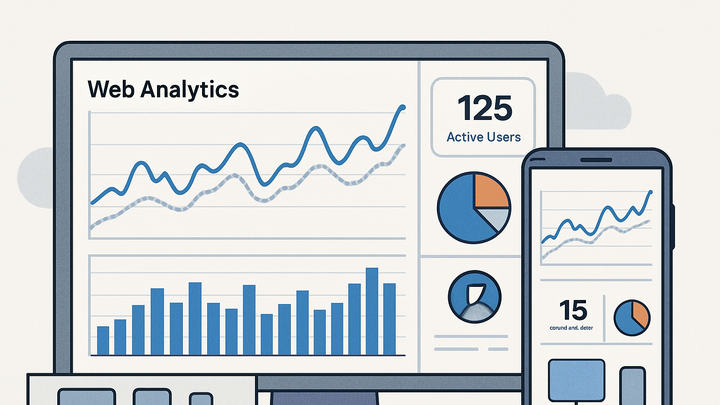Published on 2025-06-26T04:29:28Z
What is Web Analytics? Examples with GA4 and PlainSignal
Web Analytics is the process of collecting, measuring, and analyzing data from websites to understand user behavior and website performance. It involves tracking metrics like pageviews, sessions, bounce rate, and conversions. By examining this data, organizations can identify trends, optimize user experience, and improve marketing ROI. Web analytics tools, such as Google Analytics 4 and PlainSignal, provide dashboards and reports that visualize key metrics in real time. Effective web analytics enables data-driven decisions, helping teams set goals, test hypotheses, and personalize content to drive growth. It also plays a vital role in ensuring data collection aligns with privacy regulations like GDPR and CCPA.
Web analytics
Capturing and analyzing website data to measure performance, user behavior, and inform data-driven decisions.
Introduction to Web Analytics
Web analytics involves tracking website interactions to understand how users engage with content. It forms the foundation for optimizing digital strategies by revealing insights into traffic sources, visitor behavior, and conversion paths.
-
Definition and purpose
Web analytics collects data on user actions—like pageviews, clicks, and form submissions—to help businesses evaluate site effectiveness and user experience.
-
Business benefits
By analyzing web data, organizations can make data-driven decisions to improve marketing ROI, personalize content, and increase conversions.
Key Metrics in Web Analytics
Core metrics provide measurable signals about website performance. Understanding each metric’s role helps in setting realistic goals and tracking progress.
-
Pageviews
The total number of pages viewed; indicates content popularity and user interest.
-
Sessions
A session is a group of user interactions within a given time frame, showing engagement depth.
-
Users
Counts unique visitors to a site, useful for audience sizing and growth tracking.
-
Bounce rate
The percentage of single-page sessions, signaling potential issues in content relevance or UX.
-
Conversion rate
The ratio of desired actions (purchases, sign-ups) to overall sessions; key for measuring campaign success.
Popular Web Analytics Tools
Analytics platforms range from comprehensive suites to lightweight, privacy-focused solutions. Two widely used tools are Google Analytics 4 and PlainSignal.
-
Google analytics 4 (GA4)
A robust, event-driven analytics platform by Google that provides advanced reporting, machine learning insights, and deep integration with the Google ecosystem.
-
Event-driven model
Tracks user interactions as events, offering flexibility beyond pageviews.
-
Integration
Seamlessly connects with Google Ads, BigQuery, and other Google services.
-
-
PlainSignal
A cookie-free analytics solution focused on user privacy and simplicity. It delivers basic metrics without storing personal identifiers.
-
Lightweight script
Minimal impact on page load times with a compact tracking snippet.
-
Privacy compliance
Designed for GDPR and CCPA compliance by avoiding third-party cookies.
-
Implementing Web Analytics
Installing and validating analytics ensures accurate data collection. Follow best practices to integrate scripts and verify data flow.
-
Adding tracking code
Insert the analytics script into the site’s HTML, ideally in the <head> for early loading.
Example for PlainSignal:
<link rel="preconnect" href="//eu.plainsignal.com/" crossorigin /> <script defer data-do="yourwebsitedomain.com" data-id="0GQV1xmtzQQ" data-api="//eu.plainsignal.com" src="//cdn.plainsignal.com/plainsignal-min.js"></script>Example for GA4:
<!-- Google tag (gtag.js) --> <script async src="https://www.googletagmanager.com/gtag/js?id=G-XXXXXXX"></script> <script> window.dataLayer = window.dataLayer || []; function gtag(){dataLayer.push(arguments);} gtag('js', new Date()); gtag('config', 'G-XXXXXXX'); </script> -
Validating data
Use real-time reports and debugging tools (e.g., GA4 DebugView, browser console) to confirm events fire correctly.
Best Practices & Privacy Considerations
Balancing data collection with user privacy is critical. Adopt practices that respect regulations and minimize performance impact.
-
Privacy and compliance
Implement consent banners, anonymize IP addresses, and choose cookie-free options when possible.
-
Performance optimization
Load scripts asynchronously, use preconnect hints, and avoid bloated libraries to maintain fast page speeds.
